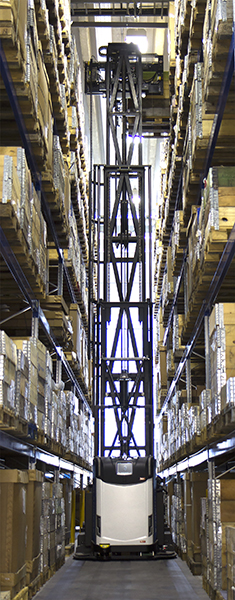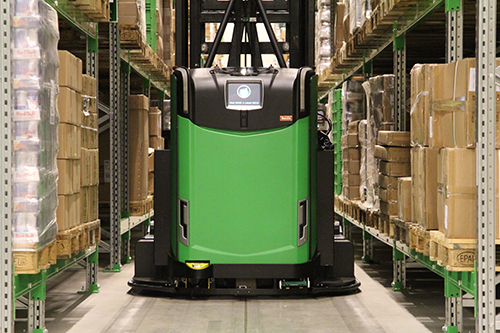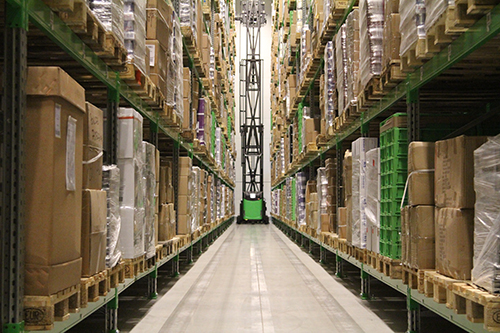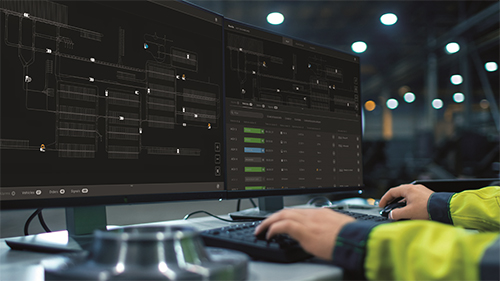Seamless Operations Orchestrated by the Next Generation Software
转载 2021-05-28 14:13 Mitsubishi Logisnext Europe Oy Source:Mitsubishi Logisnext Europe Oy
An innovative logistics solution is smart, reliable, flexible, visually appealing, and built to last. In the best-case scenario, the whole warehouse can be automated thanks to the modern developments. Most often, however, a mixed-fleet solution combining the benefits of manual and automatic operations is ideal for both warehousing and production environments. How to know which way to go, then? Let's hear from the experts.
Interest in automation is growing due to the benefits of automated operations, and the pandemic has accelerated this development as well. In warehouses and especially in reach mast environments, however, the automation level has remained relatively low. Why is that?
Kari Johansson, Solution Management Director of Mitsubishi Logisnext Europe Oy, has dug into the issue: "One presumption is that investing in automation is costly and always leads to an extensive and expensive IT project. Reach mast environments in particular are challenging due to the narrow aisles combined with high lifting and heavy loads. Significant transport flows, demands for short transportation time, and SLA requirements pose additional challenges. Companies may also worry that once they have invested in automation, any future modifications are going be expensive. However, that doesn't have to be the case. As a matter of fact, solutions to these challenges exist."
The Level of Automation Is Determined by the Process Itself
Automation offers the company a good opportunity to improve the overall effectiveness of their warehouse operations. Petri Petäys, Sales Director of Mitsubishi Logisnext Europe Oy, emphasizes the importance of analyzing the customer's processes: "Automation is all about understanding the customer's processes and offering the right solutions. The first step towards automation is process standardization. The second step is digitalization. Standardized and digitalized processes can then be automated."
Once the process has been thoroughly analyzed, it is time to assess whether the whole process or only parts of it are suitable for automation. Kari Johansson explains: "Customers prefer solutions that are easy to integrate, modular to support the actual process needs, and flexible enough to adapt to any production volume changes."
Petri Petäys continues: "Automation guarantees continuous and stable performance, but challenges may still arise because of seasonal variations. As production volume is temporarily increased, manually operated reach trucks can provide aid. Seasonal variations are a solid reason for automated guided vehicles and manually operated reach trucks to coexist."
Innovative Rocla ART Enables a Fully Automated Logistics Solution
Manually operated reach trucks are the reliable workhorses of a warehouse. Together with low-level order pickers, reach trucks make up the core of the supply chain, and the warehouse workers responsible for the load handling know the bottlenecks and the factors that slow down the process. The tendency to build upwards has led to higher warehouse racks and narrower aisles. Therefore, the driving position has become non-ergonomic. These customer needs are what triggered the innovation process of the automated reach truck Rocla ART.
Kari Johansson walks us through the challenges and solutions: "Due to the limitations of the physical outer dimensions and the AGVs' safety scanner fields, reach truck aisles have been too narrow and slow for AGV purposes. For this challenge, the solution is a more compact and agile vehicle with innovative dynamic scanning technology that enables faster turns and significantly faster load handling. The requirements of transport flow and response time can be met because of efficient load handling."
"To tackle the challenges of narrow aisles combined with high lifting of heavy loads, we utilized the experience from our own VNA AGVs (up to 12 m/39 ft lift) and manual reach trucks (up to 13 m/42 ft lift) to take the best masts from our own portfolio. As a result of combining the know-how of both manually operated warehouse trucks and AGVs, a completely new solution was born."
The automated reach truck Rocla ART is compact in size, agile in motion, fast and efficient in load handling, and with the lifting capacity of 10 m/33 ft and 1600 kg/3500 lb, it is particularly suitable for large warehousing operations. Thanks to Rocla ART, the Rocla AGV fleet is complete, and in the best-case scenarios, the whole warehouse can be automated.
Monitor, Manage, and Maintain
Traditionally, connecting the warehouse management system (WMS) with the AGV system controller has been quite extensive work. However, the new Rocla FleetController is a software solution that is connected to the WMS and keeps the AGV fleet running by automatically optimizing the orders and routes of the material flow. With the Rocla FleetController architecture, the integration requirements are much lighter than in the traditional systems. This means savings of time and money in system implementation and modernization. FleetController also comes with a Dashboard, a completely new tool for monitoring, optimizing, and improving AGV operations as well as solving any possible issues.
One of the many benefits of FleetController is the dynamic vehicle route optimization. Thanks to the unique order and route optimizing algorithms, the AGVs do more but drive less. Kari Johansson explains: "To put it simply, FleetController is both a real-time navigator and an intelligent taxi center. The system minimizes traffic jams, guides rerouting and optimizes what tasks to assign to which AGV and when. The integration with WMS is done via REST API, which minimizes the IT costs when compared to the traditional methods."
Almost Four Decades in the Automation Business
Although the ongoing digitalization is a hot topic, it has been an essential part of Mitsubishi Logisnext Europe's day-to-day operations already for decades. Almost forty years in the automation business under the brand name Rocla ensure the high quality of MLE's customer experience. Mitsubishi Logisnext Europe offers a full line of modular automation solutions that are manufactured in serial production and tailored to the needs of specific customer applications. For the customers, this means exceptionally short delivery times, easy implementation, and a lower total cost of ownership.
The reliability of the automation solution is backed up by tailored lifecycle services for the AGV system and maintenance packages for both software and hardware. Service agreements are tailored to each customer's specific needs, including a 24/7 AGV helpdesk service.
Petri Petäys summarizes: "Automation, at its best, is something you can just forget about because you do not have to worry about it at all."
Mitsubishi Logisnext Europe's (MLE Oy) AGV operations are based in Järvenpää, Finland, and are known as Rocla AGV Solutions. Rocla AGV Solutions operate globally with a highly skilled staff, benefitting from almost 40 years of experience.
Relevant Info
More- Toyota launches MyToyota Portal to revolutionise forklift fleet management
- Clark crossover forklift shows its strength at Duisburg Zoo
- Crown forklifts boost Decostar’s warehouse productivity by 18%
- Bobcat unveils first lithium-ion 3-wheel forklift in major electric push
- Toyota’s Traigo_i scoops second major design award
- Hangcha Partners With Yuantong on First NA Forklift Shipment
- HELI Launches Major Production Base in Thailand
- Grand Opening of Hangcha Middle East in Dubai
- X Series Low Level Order Picker: Move as One
- 2025 HELI Global Dealer Conference Concludes Successfully





